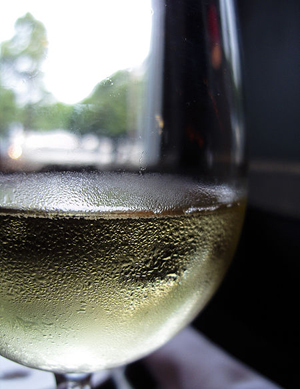
A couple of weeks ago, while reorganizing my wine cellar, I discovered a bottle of 2000 Chardonnay “Grand Vintage” from Paumanok Vineyards in Aquebogue. Worried that the wine might be over the hill (especially considering that my cellar’s dehumidifier had been blowing hot air at it), I brought it upstairs, chilled it down, and tested it a few nights later with dinner.
In my glass, the wine showed a deep yellow-gold color that was hardly reassuring. Had it already gone bad? As white wine ages, if it has been exposed to excessive heat, oxygen, or other destabilizing conditions, it will change color, from bright buttercup toward darker tones, like varnish.
Sometimes aldehydes, the same that give sherry its characteristic aroma, will develop. That’s obviously desirable if you’re making sherry, but not if you’re making chardonnay. In this case, fortunately, one whiff told me that this Paumanok Chardonnay was perfectly sound.
Rather than suffering from the ravages of time and improper storage, it had blossomed in the bottle to the apex of its potential. There were no hints of sherry, or other time-related defects like ethyl acetate (nail polish), or acetic acid (vinegar). Instead, it had developed a complex aroma of lemon peel, muskmelon, hazelnuts, pear nectar, and a soupçon of “Ma Griffe” perfume. Best of all was its dynamic balance and long, silky finish. When I woke up the next morning, its fine qualities still lingered on my palate.
This wine’s hue was partly the result of its barrel fermentation and oak aging, not oxidation. When wine is exposed to wood, it picks up some of the color of the barrel’s tannins. In fact, if you were to age water in a wine barrel, it would come out looking like golden wine, too. The depth of the wine’s hue did result from its time in the bottle, as did its extreme complexity and the lusciousness of its aroma and flavor.
If you have never experienced the difference between a young, recently released wine and the same wine, fully aged, you might not appreciate how tragic it is that restaurants and wine shops seldom want to keep or sell wine (especially white wine) long enough for it to transform, as this one did, from caterpillar to butterfly.
Restaurants generally sell white wines from the prior year’s vintage, and it’s true: few customers would choose a 9-year-old chardonnay from Long Island. They certainly won’t pay for the cost of holding a wine like that in inventory.
Today, most wines the world over are made for immediate consumption. That’s why they are so “fruit forward.” Producers need the cash flow, and most of these wines are perfectly adequate for the sort of microwaved take-out meals we now eat. Who has the patience to age wine any more, and why run the risk of seeing chardonnay turn to sherry?
Ann Marie Borghese, owner of Castello di Borghese in Cutchogue, recently expressed to a group of other growers her frustration that her customers don’t understand the potential for Long Island wines to improve with aging. She feels that Long Island wines show some of this potential simply by exposure to air, once they have been opened.
“Sometimes I’ll open a new bottle for a customer,” she said, ”and let them compare it with another bottle of the same wine that was opened the day before. The fresh bottle does show more fruit, but the opened bottle is more complex and interesting.”
This experience could not be duplicated with the wines from every region. Hotter climates produce bigger wines, but those wines are also less stable, and fade faster over time. It’s wines from cool climates, like the Rhinegau, Burgundy, and, yes, Long Island, which have the best chance of improving over time. Think about it: grapes need some heat and sunlight to ripen, but at a certain point, the most delicate aromatic precursors are burnt out by heat.
The innate aging quality of our region’s wines is a gift of nature, but it’s a gift that few appreciate. And now, at harvest time, Long Island winemakers must decide how to craft the vintage, knowing that customers will open that wine as soon as they buy it.
This is the question every winemaker must wrestle with. Is it worth putting the extra effort and risk into fully ripening the crop, separating the free run juice from the press portion, then fermenting it in expensive barrels and holding it in the bottle for customers who probably won’t take the next step and continue to hold it in the bottle?
In the case of Paumanok Vineyards, their decision (and courage) to do exactly that with the best of their 2000 Chardonnay, and my having forgotten about the bottle for eight years, led to a uniquely pleasurable gustatory experience. Let’s hope that Long Island vintners will continue to make age-worthy whites as well as reds, and that you (the consumer) will show wise and tasteful restraint and refrain from opening those wines before their time.